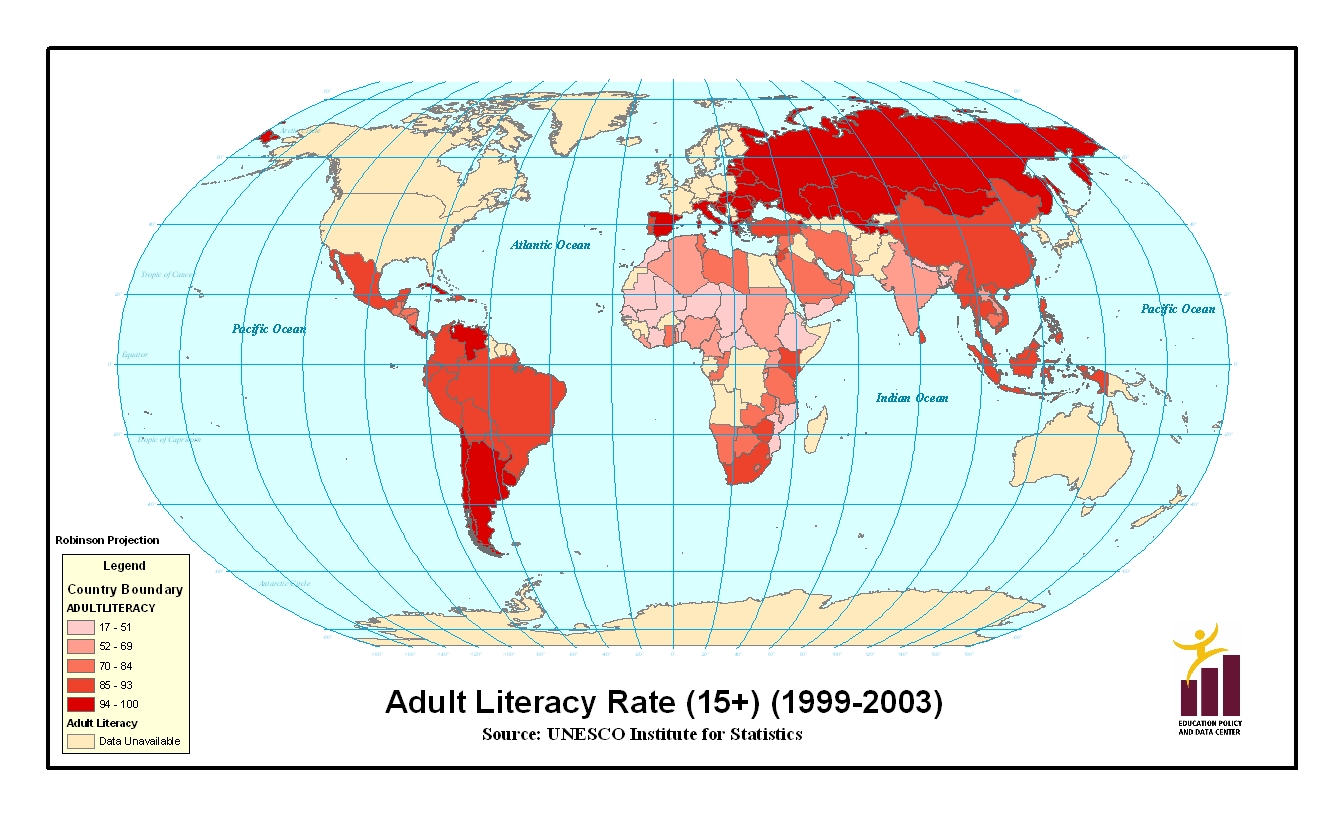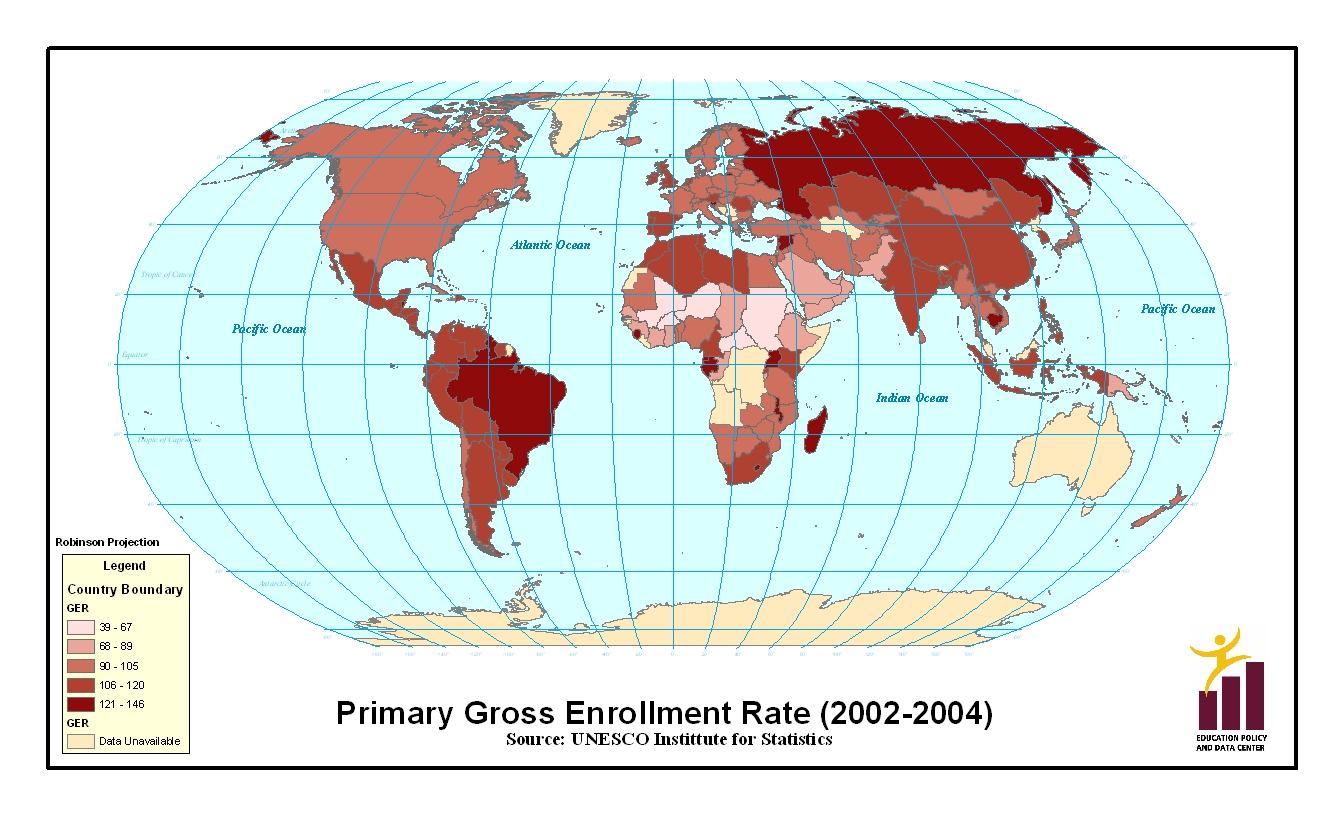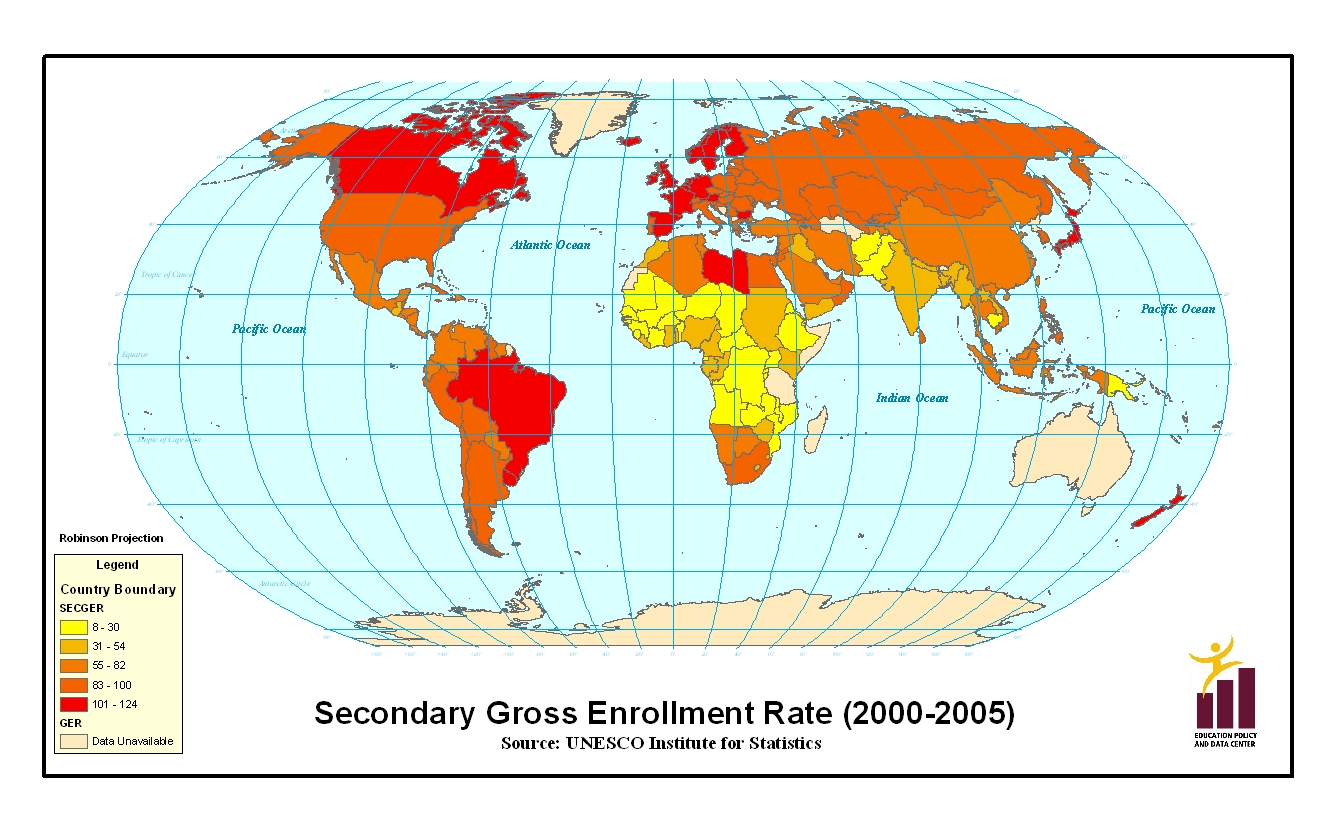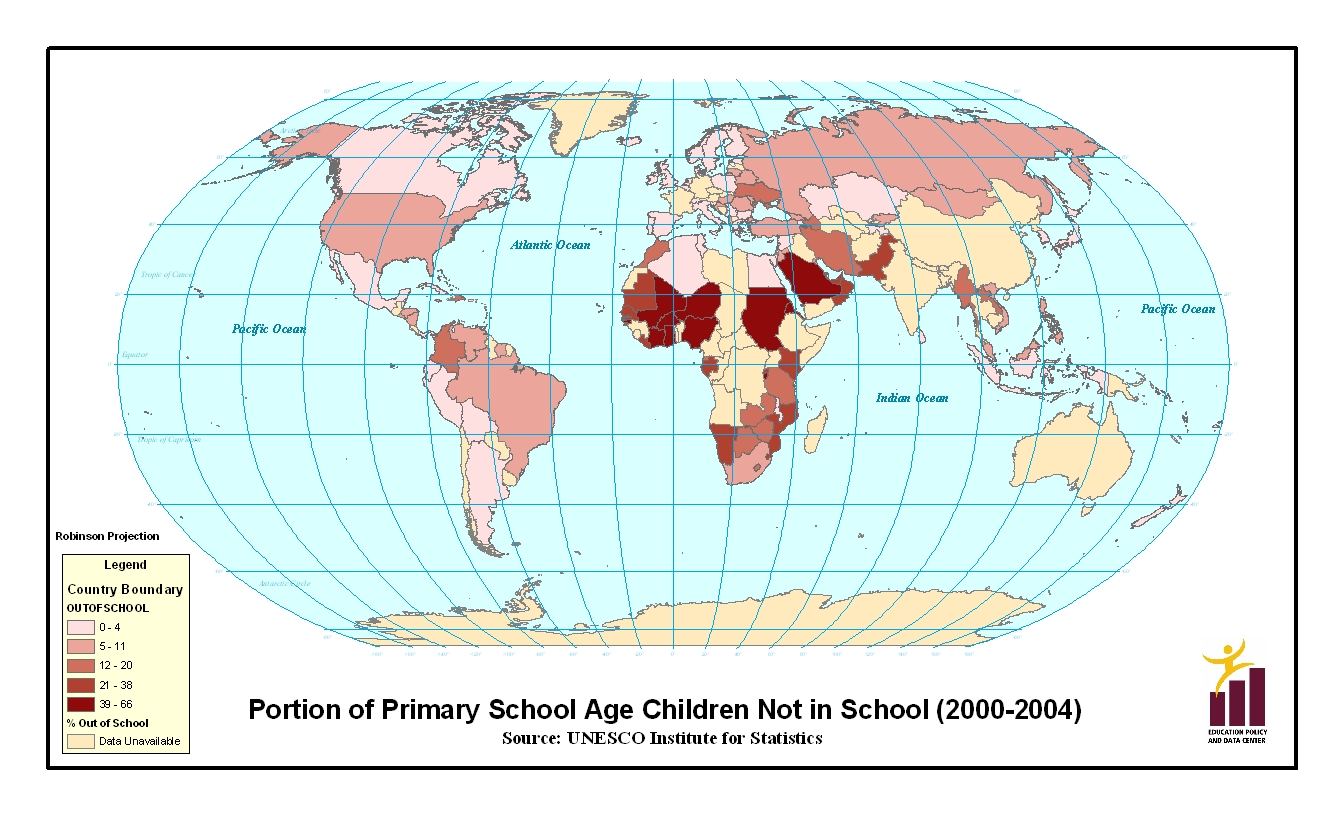EDUCATION FOR ALL
“If you think education is expensive, you should try ignorance.”
—Derek Bok, former President, Harvard University
Current Problem
876 million adults illiterate, 80% of world without access to college.
Preferred State/What the World Wants
Literacy for 100% of humanity, and access to continuing education.
Context
Buckminster Fuller proclaimed that the most important task facing
humanity was “Getting the most people ‘in the know’ about the world,
its resources, problems and options as quickly as possible.” Given
the huge impact education has on all our local and global problems,
there seems to be little with which one can argue against this point
of view. Unfortunately, the current power structure doesn’t see it
this way: an unbalanced and short-term approach to security has left
some developing nations with more soldiers than teachers and more
citizens illiterate than literate.[1] Thirty deeply in debt African
countries spend more on servicing their debts than they do on education
and health combined.[2] In developing countries about 120 million
children of primary school age (6 to 11 age-group)[3] and 275 million
at secondary level are not in school.[4] 246 million children between
ages 5 and 17 are involved in child labor.[5] While traditional efforts
to increase attendance can have some effect, school systems in most
developing countries will need assistance in attracting and keeping
enrolled all school-age children. In many cases, developing nations
cannot afford the enormous construction and infrastructure costs required
to provide U.S. style schooling for all its children. If any developing
country were to spend what the U.S. spends on its students, it would
be bankrupt within weeks.[6]
Progress has been made over the last 40 years. In 1960, only 25% of
children in Africa were enrolled in primary school. In 2000 it was
over 60%. World literacy rates have risen from around 25% in 1900
to 80% in 2000.[7] Illiteracy among adults in low-income countries
fell from 47% to 25%, and for women it fell from 57% to 32%.[8]
Higher education, college, or tertiary education as it is variously
called, is also on the rise. In 1960 there were 13 million students
pursuing higher education in the world. By 1991 this figure had risen
to 61 million, and in 2000 it was close to 75 million, and in 2003
it was at 100 million— with China having more college students than
any other country.[9] (15 million people were attending universities
in China in September 2003. After China came the United States, India,
Russia and Japan. These top five accounted for 55 million students,
about half the world total.)




Educating Humanity Strategy 1: Satellite/Television Literacy
Campaign
We have known for over thirty years that people can be taught to read,
write and do basic arithmetic through television. We have known for
at least ten years that they can do the same using computers. Using
available technologies, all children and adults who are not currently
exposed to traditional education can become literate through educational
television, computers and Internet access.
One program that could eliminate illiteracy through the use of television
would consist of ten to twelve communications satellites, approximately
10 million television receivers and satellite dish receivers, and
an equal number of solar-powered photovoltaic and storage battery
units. The television receiver units would go first to the 1.55 million
primary school teachers in the 41 least developed countries,[10] followed
by teachers in developing countries with the highest illiteracy rates.
The satellites and their launching would cost about $2 billion; the
televisions, dish receivers and photovoltaic/battery units for 2 million
teachers would be about $400 million.[11]
In this plan, the software (the actual television programming), would
be the "expensive" part. Special teams assembled from each
unique culture would create it. These teams, made up of educators,
poets, scientists, musicians and other leaders in their fields would
celebrate the diversity of each culture, instead of homogenizing it
through programming that is similar or identical to American or other
programming. In addition to literacy programming, such an educational
infrastructure could be the vehicle for programming on health maintenance,
sanitation measures, agricultural productivity and other subjects
that would benefit each society.
Coupling a computer and Internet access to the above television would
add enormous benefit to the poor of the world, as well, as will be
seen later, to the entire world.
There is a direct and strong correlation between increased literacy
and elevated worker productivity and higher GNP.[12] Along with the
higher productivity come higher incomes. One OECD study points to
a doubling of income for those who complete secondary education over
those who do not finish.[13] Annual returns on investments in education
for successful students range from 6.5% to nearly 17% in developed
countries.[14] Life expectancy, infant mortality and income per capita
are all improved by education.[15] Economic growth and lowered fertility
rates also result from increased education.[16]
A WHO study found that the most efficacious thing that can be done
for lowering infant mortality is not getting more doctors, nurses,
health technicians, hospitals, or clinics into a country, it is women’s
literacy. As women’s literacy goes up, infant mortality goes down.
The cost for the hardware and software for the Satellite/Television
Literacy Campaign is $5 billion. Using more traditional educational
techniques could also eliminate illiteracy from the world. A UNICEF
study points out that achieving universal primary schooling for Africa
would cost $2 billion.[17] Doing the same for the entire the world
would cost $9 to $12 billion per year.[18] The UNDP thinks it could
be done for $6 billion per year. [19]
“Education is the ability to perceive the hidden connections between
phenomena.”
—Vaclav Havel
Educating Humanity Strategy 2: Internet Access for All
The educational opportunities existing on the Internet are vast, unprecedented
and largely untapped. The courses, curriculum, syllabi, databases,
even entire schools (such as MIT[20]) that have their educational
resources available for free over the Internet could open up a quality
higher education to hundreds of millions, even billions, of people
currently without any access to college level education. The experience
would be different than what is commonly thought of as “college” in
developed countries, but that does not mean that a well-designed college
level Internet course or education need be inferior.
The potential for the Internet to raise the educational level of large
segments of the world’s population is huge, but connecting everyone
in the world to the Internet also offers other benefits that will
accrue to the entire network— including those in the wealthy parts
of the world that have enjoyed and benefited from Internet access
for over a decade.
At its most general level, this can be explained by Metcalf’s Law
that states that the value of a network is a function of the number
of nodes connected to that network. More precisely, the value of
a network rises with the square of the number of participants. For
example, if the network has two people connected to it, and we assign
a value of “1” to each participant, the network has a value of “4.”
If there are 3 participants, the value of the network is 9. If there
are 1000 participants, the value of the network is 10002 or 1 million.
If the Internet has 600 million active users or nodes (as it does
in 2003[21]), and each user is given the value of 1, then the entire
network has a value of 360,000 trillion.
Connecting the entire world to the Internet, making sure that every
person over the age of 10 has easy access to the Internet and its
educational resources, will not only provide those people currently
without Internet connection access to the vast educational richness
of the Internet, but enrich the Internet as well.
(In addition to strictly educational uses, the Internet can be used
to link farmers to markets, patients to doctors, craft workers to
customers, suppliers to corporate buyers, and parents to children.
All this will accelerate local economic development, increase health
and well being, foster communication and economic ties between neighbors
and strangers alike.)
Building the high-speed wireless connection devices (or wire ones
where appropriate and economical) will be a huge market and benefit
to the global telecommunications industry. Manufacturing the computers
and/or Internet access devices in the developing countries where the
products will be used would also provide jobs, infrastructure, and
technological expertise. Training the technicians for installation,
maintenance, and upgrading of the network and its access technology
would provide additional jobs and expertise to the developing country.
Providing electricity for Internet access through solar cells and
other decentralized energy production technologies would provide electricity
for a host of other important basic human need devices such as lighting,
water pumping, and refrigeration (see Chapter 10, Energy for All).
The mass production of these devices to meet such a large global need
would accelerate the lowering of the costs of these devices for the
entire world,[22] and make ever more feasible and economical the phasing
out of fossil and nuclear fueled energy production.[23]
A vital part of connecting the entire world to the Internet, as in
the educational satellite/television strategy above, is the appropriate
matching of the educational needs of a country and person in the developing
world to the vast and seemingly unorganized resources of the Internet.
To make the appropriate matches of need to capacity, teams from each
country will assemble different Internet based courses for the people
in their region. The first courses will be organized around the real
world needs of the poor, not the advanced educational needs of the
well-educated elite. Courses on topics such as increasing agricultural
productivity, providing safe water and sanitation facilities, and
affordable, abundant and clean energy supplies would be organized
and offered. Other courses, organized around traditional higher education
academic subjects would quickly follow.
“Throughout the history of education there has been an insidious
link between quality and exclusivity in education… the good tidings
is that technology has shown that it can break that insidious link
once and for all.”
—John Daniel, UNESCO
Open Internet University
To facilitate the rapid development of college level courses on the
Internet the non-profit Open Internet University will be initiated.
This university will organize and make available at one site all the
current college level offerings that exist on the Internet. It will
do this in the context of a full university’s course offerings, thereby
locating the courses that are missing or weak. With this knowledge
it will invite teacher’s from around the world to prepare or upgrade
the needed courses.
Each college and university in the world will be invited to prepare
one “showcase” course that will display its educational prowess.
Every college or university in the world has at least one teacher
whose ability to inform and inspire students is near legendary. Students
know who these teachers are (administrators rarely do) and do whatever
it takes to get into theircourses. Most of these teachers leave a
legacy of people who have switched majors, chosen careers, and have
gone on to accomplish great things based on the direction and inspiration
they received from the one fantastic teacher who touched them with
the power and magic of learning. The best teacher at each school (not
the best researcher or most famous) will be invited to prepare a course
for the Open Internet University thereby culling and leveraging one
of the world’s most valuable resources in a way that will benefit
all of humanity. Everyone everywhere will be able to take a course
from the world’s most inspiring teachers. Having a full university’s
course offerings taught by the world’s best teachers will unleash
more creative potential into the world than almost anything.
One of the Open Internet University’s features will be that all its
courses to the developing world will be free. Those to the developed
world will have modest fees, set at a rate at least an order of magnitude
lower than standard universities. The bulk of the fees will go to
the teachers and their home institutions, thereby setting in motion
a competitive drive for teaching excellence. The best, most informative
and inspiring courses will have the most students. Students from developing
countries attending for free will also contribute to the reward structure
by evaluating courses. Annual Open Internet University Education
Excellence Awards will be given to the best courses.
“’Doing Science’— conducting actual research side by side with
researchers—is perhaps the best way to achieve scientific literacy.”[24]
—Project JASON
Another feature of the Open Internet University, one greatly enhanced
by its Internet backbone, is collaborative projects and research by
students. Internet connections allow students to learn from each
other as well as great teachers. The social dimension of learning
can be enhanced, not dimensioned, by using collaborative projects
over the Internet. “Distance learning” does not need to be synonymous
with isolated learning. More importantly, these collaborative projects
need not (and should not for the learner’s sake) be merely academic
exercises. They can be engagements in bonifide research that will
help the world. A global community of learners, working together
with inexpensive but accurate instruments could measure local environmental
conditions, including such things as air, water, and soil temperatures,
soil and water pH, water salinity, light intensity, UV radiation,
ozone and CO levels as well as conditions of locall flora and fauna.
Local GIS mapping could be carried out that would be part of global
efforts to map a specific resource, problem or opportunity. A prototype
of a version of this is the U.S. National Science Foundation funded
Global Laboratory that has linked over 300 school classes in 20 countries.[25]
“If classrooms in the heart of the Amazon rainforest can now exchange
cultural and scientific data with scientists throughout the world,
we can only imagine where science education will be in another ten
years.”[26]
—Project JASON
In summary, the addition of three to four billion people to the Internet
will have profound impacts on many facets of the Internet, as well
as education, the growth of democracy, global and local problem solving,
decision-making, research, communication in general and across cultures
in particular, progress, and the general quality of life.
“Educate and inform the whole mass of the people… They are the
only sure reliance for the preservation of our liberty.”
—Thomas Jefferson

Costs/Benefits—Educating Humanity
The costs of launching a satellite network, providing solar-powered
television sets and satellite receivers to villages without adequate
schools and developing appropriate programming for the satellite-based
education initiative would total about $2 billion per year for twenty
years.[27] (This yearly cost is less than the cost of one B-2 bomber.[28])
Supplying textbooks, teaching aids, in-service teacher training and
supervision would cost about $3 billion additional per year (about
half what U.S. consumers spend on t-shirts[29]). $1.4 billion ($140
million per year for ten years) would train 1 million new teachers
in Africa.[30]
The costs of global wireless Internet access via communications satellites,
and land-based technology where appropriate, would cost $4 billion
per year for ten years. An additional $1 billion per year for ten
years would be invested in the preparation of already existing Internet
materials for use in developing countries.
The total amount for both the educational television and global Internet
education access strategies is $10 billion per year for ten years.
This is less than .008 (8 tenths of 1%) of the global telecommunications
industry revenues.[31] It is also about 1.1% of the world’s total
annual military expenditures, or 5% of worldwide annual illegal drug
sales, or 12.5% of the cost of Gulf War 1,[32] or 2.8% of the 2003
tax cut given to the richest U.S citizens.[33]
The benefits of just reducing child labor through universal education
for children up to the age of 14 would be over $5 trillion.[34] Other
benefits of an improved education and literacy program would include
enhancing the quality of life for newly literate citizens now able
to access written media, longer and healthier life spans attributable
to easier and wider communication of sanitation and other simple disease
prevention techniques, increased job skills and employment options,
a more attractive local economy to outside investment, an increase
in GDP,[35] a reduction in industrial and agricultural accidents as
warning signs and instructions can be read by a wider population,
and increased political participation.
Investing in education leverages the food, water, sanitation, and
shelter advances described in previous chapters. Education gives
weight to all the previous advances in human well being and wealth
creation— providing, either sooner or later, what is needed for the
tipping point to be reached for global society. What happens when
the tipping point tips? Before we can describe this amazing phenomenon,
we need to examine some of our other needs. Energy, and an affordable,
safe, and clean supply of it, being crucial.
“Scientific understanding is no longer only a desirable good but
clearly an imperative for building truly representative democracies.”
—Peter Raven, President, American Association for the Advancement
of Science, 2001
“Educate part of a community and the whole benefits.”
—Amartya Sen, Nobel Prize, Economics
“The best defense against terrorism is an educated people.”
—Peter Raven, President, American Association for the Advancement
of Science, 2001
“The world is in a race between education and catastrophe.”
—H. G. Wells
------------------------------------------------------------------------
[1] 47 countries have more armed forces than teachers (UNDP Human
Development Report, 1995, pp.162-163.); 33 countries have more illiterates
than literates (UNDP, pp. 130-131.); In "least developed countries",
there are 121 soldiers for every 100 teachers; the literacy rate is
37% (1985). The 1985 literacy rate for the "developing” world
is 60%. (UNDP, pp. 21, 78.). By 2000, this figure has climbed to over
80% (UNESCO 2000 Yearbook, Paris, UNESCO 2000).
[2] “No school, no future,” (The Economist, March 27, 1999, p. 45).
[3] UNICEF, State of the World’s Children 2003, http://www.unicef.org/sowc03/brief1.htm
[4] UNDP, Human Development Report 1995 (New York, Oxford University
Press, 1995, p. 16).
[5] Investing in Every Child: An economic study of the costs and benefits
of eliminating child labor, (International Labor Organization, December
2003).
[6] U.S. education expenditure per capita is $928 (5.3% of GNP).
Population of developing world is 3.78 billion; multiplying the two
gives $3.5 trillion, or 130% of the GNP of the developing world ($2.7
trillion).
[7] UNESCO 2000 Yearbook, (Paris, UNESCO 2000).
[8] World Development Report 2003, (The World Bank, Washington DC,
2003, p. 6).
[9] “China's Number of College Students Tops the World,” (China Today,
October 2003, http://www.chinatoday.com.cn/English/e200310/f6.htm).
[10] UNESCO Statistics Survey 2000. wwww.unesco.org
[11] Each satellite would cost about $150 million; each television
is $50.; each dish receiver is $50.; each photovoltaic power unit
is $100.
[12] Literacy correlates with cereal yields: 0.653; literacy with
GNP/capita: 0.584; literacy with calorie consumption: 0.672. Correlations
were done in the software program Global Data Manager. Literacy rate
is from Central Intelligence Agency, World Factbook 1989 (Washington,
D.C.: CIA, 1989). GNP/capita is from The World Bank, pp. 178-179.;
cereal yield is from World Resources Institute, pp. 278-279.; calorie
consumption is from FAO, pp. 291-292; infant mortality and life expectancy
are from World Population Data Sheet 1990. Also see The World Bank,
The Contributions of Education to Economic Growth: International Comparisons.
World Bank Reprint Series, No. 320 (Washington, D.C.: The World Bank,
1985), where it is pointed out that 4 years of primary education is
associated with an average increase in farm productivity of 10% or
more.
[13] “Income by educational attainment,” (The Economist, June 23,
2001, p. 104).
[14] “Returns to education,” (The Economist, November 2, 2002, p.
96).
[15] Literacy with infant mortality: -0.815 ; literacy with life
expectancy: 0.822. Correlations were done in the software program
Global Data Manager. For sources of data, see endnote #80. On average,
each additional year of schooling is associated with a decrease in
infant mortality rate of approximately 9 per 1000; K. Hinchliffe,
The Monetary and Non-Monetary Returns to Education in Africa. The
World Bank Education and Training Series, Report EDT46 (Washington,
D.C.: The World Bank, 1986).
[16] “No school, no future,” (The Economist, March 27, 1999, p. 45).
[17] ibid.
[18] “Enough talk,” (The Economist. November 24, 2001 p.14).
[19] UNDP Human Development Report 1998 www.undp.org
[20] “MIT Offers World-Class Courses, for Free,” (Science, August
31, 2001, p. 1618).
[21] Vital Signs 2003 (Worldwatch Institute, Washington DC, 2003,
p. 60).
[22] P.D. Maycock and E.N. Stirewalt, A Guide to the Photovoltaic
Revolution, (Emmaus, PA: Rodale Press, 1986), p. 90-93.
[23] To replace the amount of electricity presently being produced
by nuclear power plants in the U.S. would require approximately 1300
square miles of Arizona or New Mexico desert, an area about 36 miles
by 36 miles square with photovoltaic efficiency of 8% operating at
10 hours per day.
[24] “The Spirit of Discovery,” (Science, March 3, 2000, p. 1595).
[25] “The World’s Biggest Science Class,” (UNESCO Sources February
1998, p.11).
[26] “The Spirit of Discovery,” (Science, March 3, 2000, p. 1595).
[27] V. Zinger and M. Gabel, World Deficit Report 3: World Literacy
(Philadelphia: World Game Institute, 1988), p. 10.
[28] Center for Defense Information, http://www.cdi.org/issues/aviation/B296.html
[29] State of the World 2004, (Washington D.C., Worldwatch Institute,
2004 p. 163).
[30] “Down with school fees,” $40 million is the amount needed to
train 29,000 teachers in Angola. (The Economist December 13, 2003,
p. 44).
[31] Telecommunications industry revenues in 2003 are $1.37 trillion,
according to the International Telecommunications Union, as reported
in “Beyond the bubble,” (The Economist, October 11, 2003).
[32] The 1991 Gulf War cost $80 billion (in 2002 dollars); “Increases
in Military Spending and Security Assistance Since 9/11/01,” Arms
Trade Resource Center, October 4, 2002 (World Policy Institute, Washington
DC 2003).
[33] 2003 tax cut was for $350 billion.
[34] Investing in Every Child: An economic study of the costs and
benefits of eliminating child labor, (International Labor Organization,
December 2003).
[35] An increase of one year in average years of education may lead
to a 3% rise in GDP. The World Bank, World Development Report 1990
(New York: Oxford University Press, 1990)
Back to Price of Peace